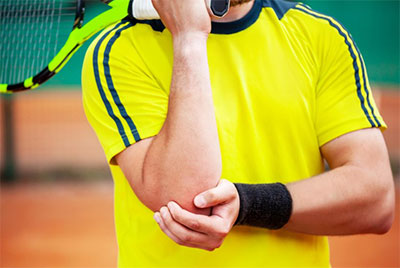
Tennis elbow doesn’t just affect the game of tennis, in fact, Tom Brady suffered from tennis elbow in 2019. For most people, tennis elbow affects the game of life.
Less than 5% of tennis elbow cases are people who actually play tennis; more often, it happens to those who repeatedly use their elbow, wrist, and hands for their job, sport, or hobby. Tennis elbow, or lateral epicondylitis, is a wear and tear injury that occurs from damaging the elbow tendons that connect the forearm muscles to the elbow joint.
This common orthopedic issue typically affects people between the ages of 30 and 50 years old. The symptoms of tennis elbow develop gradually and include elbow pain or burning that slowly worsens and results in a weakened grip. Simple movements that use the affected tendon like shaking hands, opening a door, or turning a key will cause pain.
There are many treatment options for tennis elbow. An orthopedic surgeon will diagnose the condition based on the symptoms and imaging tests such as X-rays or an MRI scan to confirm the diagnosis and rule out any other issues.
Top Nonsurgical Treatment Options
- Rest - Give the injured arm significant rest. Stop participation in sports or heavy work activities for several weeks.
- Bracing - Use a brace centered over the forearm to help relieve symptoms of tennis elbow and provide stabilization.
- Physical therapy rehabilitation- After allowing time to recover, talk to a doctor or a physical therapist about specific exercises to strengthen the forearm muscles and warm up the elbow joint to minimize re-injury risk.
- Non-steroidal anti-inflammatory medicines - Medicines like aspirin or ibuprofen may be used to reduce pain and swelling.
- Corticosteroid injections - If the tennis elbow does not begin to heal after two months of rest and rehabilitation, corticosteroid injections may aid the healing process.
- Platelet-rich plasma therapy (PRP) - PRP offers advanced treatments that utilize platelet-rich plasma and stem cells derived from your own body to encourage regrowth of injured tendons, aid the body’s natural healing potential and help the regeneration of tissue.
It is estimated that approximately 80% to 95% of patients have success with nonsurgical treatment. If the symptoms do not respond after 6 to 12 months of nonsurgical treatments, surgery may be recommended. In most cases, the surgery can be performed as a minimally invasive procedure in an outpatient setting.
Don’t let tennis elbow affect your game. If you are experiencing pain in your elbow, call the Center for Orthopaedics and Sports Medicine to have your elbow evaluated, so you can get back in the game of life. Please call (703) 848-0800 or click here to request an appointment online for all appointments and inquiries
Dr. Ramesh Chandra has been practicing orthopedic surgery in the Washington DC Metropolitan area since 1984. The Center for Orthopedics and Sports Medicine is easily accessed from anywhere in the Washington DC metropolitan area, with offices located in Falls Church, Reston/Herndon, and Tysons Corner.












